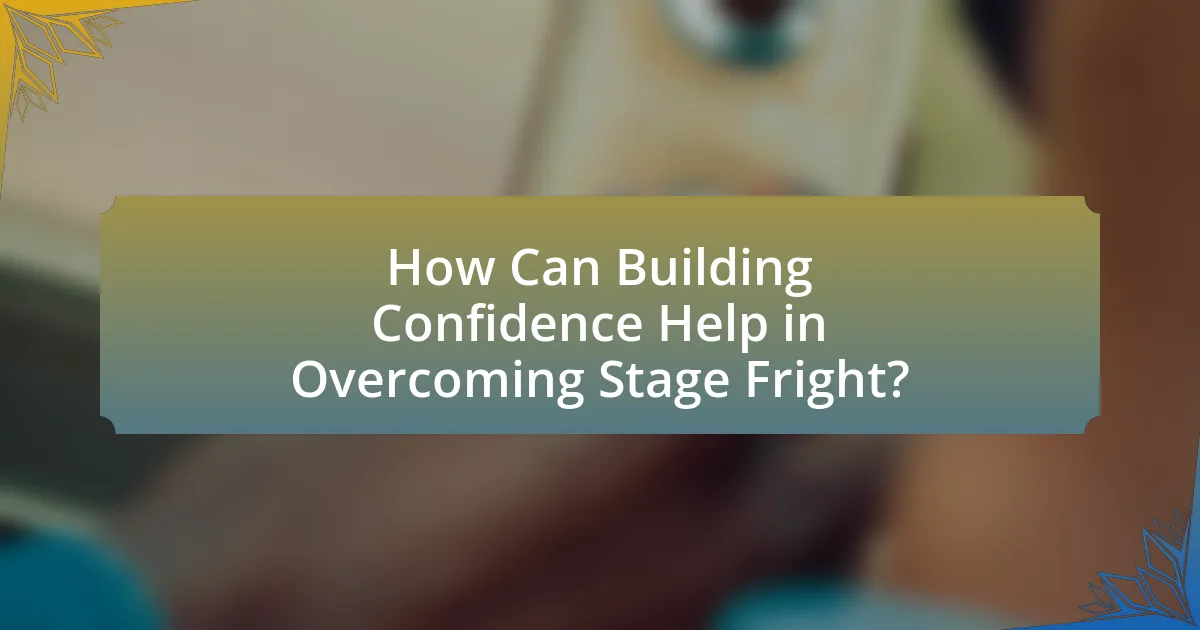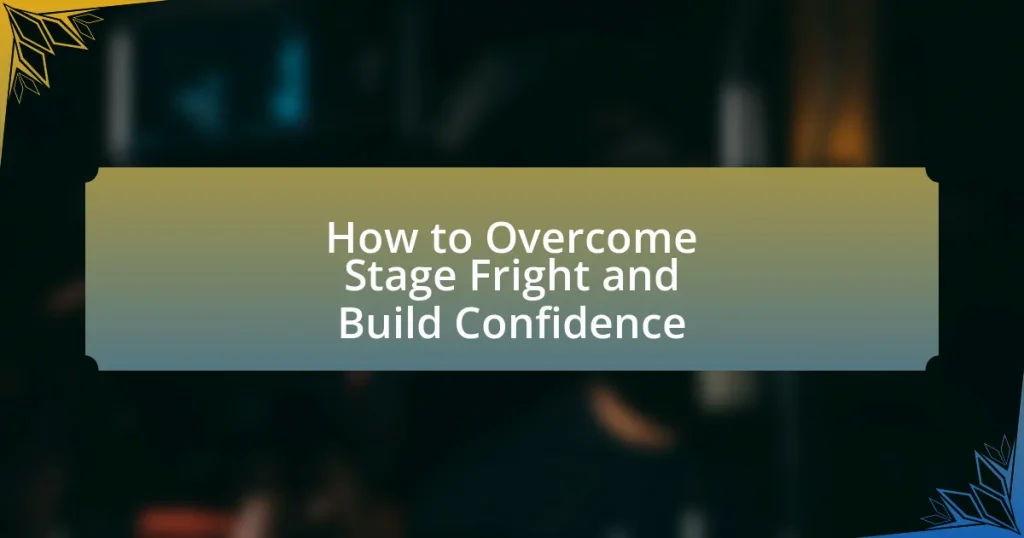Stage fright is a psychological condition marked by intense anxiety and fear experienced during performances in front of an audience, affecting approximately 75% of individuals. This article explores the manifestations of stage fright, including physical symptoms like increased heart rate and sweating, as well as emotional responses that contribute to performance anxiety. It examines the role of personality traits, past experiences, and effective strategies for overcoming stage fright, such as thorough preparation, visualization techniques, and controlled breathing exercises. Additionally, the article highlights the importance of building confidence through self-awareness, positive self-talk, and regular practice in public speaking to effectively manage and reduce stage fright.

What is Stage Fright and Why Does It Occur?
Stage fright is a psychological condition characterized by intense anxiety and fear experienced by individuals when performing in front of an audience. This phenomenon occurs due to a combination of factors, including the fear of negative evaluation, the pressure to perform well, and the activation of the body’s fight-or-flight response, which can lead to physical symptoms such as increased heart rate and sweating. Research indicates that approximately 75% of people experience some level of stage fright, highlighting its prevalence and the commonality of performance anxiety.
How does stage fright manifest in individuals?
Stage fright manifests in individuals through a range of physical and psychological symptoms. Common physical symptoms include increased heart rate, sweating, trembling, and dry mouth, which can occur due to the body’s fight-or-flight response. Psychologically, individuals may experience anxiety, fear of judgment, and a sense of impending doom, leading to difficulty concentrating or remembering lines during a performance. Research indicates that approximately 75% of people experience some form of anxiety related to public speaking, highlighting the prevalence of stage fright.
What physical symptoms are associated with stage fright?
Physical symptoms associated with stage fright include increased heart rate, sweating, trembling, dry mouth, and nausea. These symptoms arise from the body’s fight-or-flight response, which is triggered by anxiety in performance situations. Research indicates that approximately 75% of individuals experience some form of anxiety related to public speaking, leading to these physiological reactions.
How do emotional responses contribute to stage fright?
Emotional responses significantly contribute to stage fright by triggering physiological reactions such as increased heart rate, sweating, and muscle tension. These responses stem from anxiety and fear of negative evaluation, which can lead to a heightened state of arousal that impairs performance. Research indicates that individuals experiencing stage fright often report feelings of panic and dread, which can create a feedback loop that exacerbates their anxiety. For instance, a study published in the Journal of Anxiety, Stress, & Coping found that cognitive appraisal of performance situations directly influences emotional responses, thereby affecting overall performance quality.
Why do some people experience more stage fright than others?
Some people experience more stage fright than others due to a combination of personality traits, past experiences, and physiological responses. Individuals with high levels of anxiety or introversion are more likely to feel nervous in public speaking situations, as their temperament predisposes them to fear judgment or negative evaluation. Research indicates that approximately 20% of the population suffers from social anxiety disorder, which can significantly heighten feelings of stage fright. Additionally, past negative experiences, such as a poor performance or criticism, can create a lasting impact, leading to increased fear in future situations. Physiologically, the body’s fight-or-flight response can trigger symptoms like increased heart rate and sweating, further exacerbating the feeling of stage fright.
What role does personality play in stage fright?
Personality significantly influences stage fright, as traits such as introversion and high levels of neuroticism are associated with increased anxiety in performance situations. Research indicates that individuals with introverted personalities often experience heightened self-consciousness and fear of negative evaluation, which can exacerbate feelings of stage fright. Additionally, a study published in the Journal of Personality and Social Psychology found that people with high neuroticism are more likely to experience anxiety and stress in social situations, including public speaking. Thus, personality traits play a crucial role in determining the intensity of stage fright experienced by individuals.
How do past experiences influence stage fright levels?
Past experiences significantly influence stage fright levels by shaping an individual’s perception of performance situations. For instance, negative past experiences, such as a previous failure or embarrassing moment on stage, can lead to heightened anxiety and fear of similar outcomes in future performances. Research indicates that individuals who have faced criticism or ridicule during past presentations often develop a heightened sensitivity to potential judgment, which exacerbates stage fright. Conversely, positive experiences, such as successful performances or supportive feedback, can enhance confidence and reduce anxiety, leading to lower levels of stage fright in future situations. This relationship between past experiences and stage fright is supported by psychological theories, such as the cognitive-behavioral model, which emphasizes how previous encounters can influence current emotional responses and behaviors.

What Strategies Can Help Overcome Stage Fright?
To overcome stage fright, individuals can employ several effective strategies, including thorough preparation, visualization techniques, and controlled breathing exercises. Thorough preparation involves practicing the material extensively, which builds confidence and reduces anxiety. Visualization techniques, such as imagining a successful performance, can help create a positive mindset and alleviate fear. Controlled breathing exercises, which focus on slow, deep breaths, can calm the nervous system and reduce physical symptoms of anxiety. Research indicates that these methods significantly enhance performance and reduce anxiety levels in public speaking scenarios, as evidenced by a study published in the Journal of Anxiety, Stress, & Coping, which found that participants who practiced these techniques reported lower anxiety and improved performance outcomes.
How can preparation reduce stage fright?
Preparation can significantly reduce stage fright by increasing familiarity with the material and boosting confidence. When individuals thoroughly prepare, they become more knowledgeable about their content, which minimizes uncertainty and anxiety. Research indicates that rehearsing a presentation multiple times can lead to a 20% reduction in anxiety levels, as familiarity breeds comfort. Additionally, preparation allows individuals to anticipate potential challenges and develop strategies to address them, further alleviating fear. Thus, effective preparation directly correlates with reduced stage fright by enhancing confidence and control over the performance.
What techniques can be used for effective practice?
Effective practice techniques for overcoming stage fright and building confidence include systematic desensitization, visualization, and deliberate practice. Systematic desensitization involves gradually exposing oneself to the anxiety-inducing situation, such as performing in front of an audience, which helps reduce fear over time. Visualization entails mentally rehearsing the performance, allowing individuals to create a positive outcome in their minds, thereby boosting confidence. Deliberate practice focuses on specific skills and feedback, ensuring that individuals refine their abilities through targeted efforts. Research indicates that these techniques can significantly enhance performance and reduce anxiety, as evidenced by studies showing that visualization can improve athletic performance by up to 45% (Cumming & Williams, 2012, “Imagery in Sport”).
How does understanding the audience help alleviate fear?
Understanding the audience helps alleviate fear by enabling the speaker to tailor their message and approach to meet the audience’s expectations and needs. When speakers recognize the demographics, interests, and emotional states of their audience, they can create a more engaging and relatable presentation, which fosters a sense of connection. Research indicates that speakers who feel connected to their audience report lower anxiety levels; for instance, a study published in the Journal of Communication found that audience engagement significantly reduces perceived threat levels during public speaking. This connection diminishes feelings of isolation and fear, allowing the speaker to focus on delivering their message effectively.
What mental strategies can be employed to combat stage fright?
Cognitive restructuring is a mental strategy that can effectively combat stage fright. This technique involves identifying and challenging negative thoughts associated with performance anxiety, replacing them with positive affirmations and realistic expectations. Research indicates that cognitive-behavioral therapy (CBT), which includes cognitive restructuring, has been shown to reduce anxiety symptoms in performers, as evidenced by a study published in the Journal of Anxiety Disorders, where participants reported significant decreases in performance anxiety after undergoing CBT. Additionally, visualization techniques, where individuals mentally rehearse their performance in a calm and successful manner, can further enhance confidence and reduce fear.
How does visualization contribute to confidence building?
Visualization enhances confidence building by allowing individuals to mentally rehearse successful outcomes in various situations. This mental practice creates a sense of familiarity and preparedness, which reduces anxiety and boosts self-assurance. Research indicates that athletes who engage in visualization techniques experience improved performance and increased confidence levels, as evidenced by a study published in the Journal of Applied Sport Psychology, where participants who visualized their performances reported higher confidence and better outcomes compared to those who did not.
What role does positive self-talk play in overcoming fear?
Positive self-talk plays a crucial role in overcoming fear by reshaping an individual’s mindset and reducing anxiety. When individuals engage in positive self-talk, they replace negative thoughts with affirmations that promote confidence and calmness, which can significantly diminish feelings of fear. Research indicates that positive self-talk can enhance performance and reduce stress levels, as demonstrated in a study published in the Journal of Sport & Exercise Psychology, where athletes who practiced positive self-talk showed improved performance and lower anxiety compared to those who did not. This evidence supports the effectiveness of positive self-talk as a strategy for managing fear, particularly in high-pressure situations like public speaking or performances.

How Can Building Confidence Help in Overcoming Stage Fright?
Building confidence significantly aids in overcoming stage fright by reducing anxiety and enhancing performance. When individuals possess a strong sense of self-assurance, they are less likely to succumb to fear and more capable of focusing on their presentation or performance. Research indicates that confidence can lead to improved physiological responses, such as lower heart rates and reduced cortisol levels, which are commonly associated with anxiety. Furthermore, a study published in the Journal of Applied Psychology found that individuals who practiced positive self-affirmation techniques reported higher confidence levels and subsequently performed better in public speaking scenarios. This evidence underscores the direct correlation between confidence and the ability to manage stage fright effectively.
What are the key components of building confidence?
The key components of building confidence include self-awareness, positive self-talk, goal setting, and practice. Self-awareness allows individuals to understand their strengths and weaknesses, which is essential for personal growth. Positive self-talk helps to counter negative thoughts and reinforces a constructive mindset. Goal setting provides clear objectives, enabling individuals to track progress and celebrate achievements, which boosts confidence. Finally, consistent practice in relevant skills or situations, such as public speaking, enhances competence and reduces anxiety, further contributing to increased confidence.
How does setting achievable goals enhance self-confidence?
Setting achievable goals enhances self-confidence by providing individuals with a clear path to success and measurable accomplishments. When people set realistic and attainable goals, they experience a sense of progress and achievement, which reinforces their belief in their abilities. Research indicates that achieving small, incremental goals can lead to increased self-efficacy, as demonstrated in a study published in the Journal of Personality and Social Psychology, where participants who set and achieved specific goals reported higher levels of self-confidence compared to those who did not. This process of setting and achieving goals creates a positive feedback loop, where each success builds on the last, ultimately leading to greater self-assurance in various situations, including overcoming stage fright.
What practices can reinforce a positive self-image?
Practices that can reinforce a positive self-image include engaging in positive self-talk, setting achievable goals, and practicing self-compassion. Positive self-talk involves replacing negative thoughts with affirming statements, which has been shown to improve self-esteem and overall mental health. Setting achievable goals allows individuals to experience success, thereby enhancing their self-worth and confidence. Practicing self-compassion encourages individuals to treat themselves with kindness during failures, fostering resilience and a healthier self-image. Research indicates that self-compassion is linked to greater emotional well-being and lower levels of anxiety and depression, supporting the effectiveness of these practices in building a positive self-image.
How can regular exposure to public speaking improve confidence?
Regular exposure to public speaking significantly improves confidence by enhancing communication skills and reducing anxiety associated with speaking in front of others. Engaging in public speaking frequently allows individuals to practice and refine their delivery, which leads to greater familiarity with the process and a decrease in fear. Research indicates that repeated practice can lead to desensitization to the stress of public speaking, as evidenced by a study published in the Journal of Applied Psychology, which found that individuals who participated in regular public speaking engagements reported increased self-efficacy and reduced anxiety levels over time. This consistent exposure fosters a sense of competence and mastery, ultimately boosting overall confidence in both personal and professional settings.
What are some effective ways to practice public speaking?
Effective ways to practice public speaking include joining a public speaking group, such as Toastmasters, which provides structured opportunities for practice and feedback. Regularly rehearsing speeches in front of friends or family can also enhance confidence and delivery skills. Recording practice sessions allows speakers to review their performance and identify areas for improvement. Additionally, practicing in front of a mirror helps in observing body language and facial expressions. Research indicates that consistent practice leads to improved public speaking skills and reduced anxiety, as evidenced by a study published in the Journal of Communication Education, which found that participants who practiced regularly reported higher confidence levels and better performance outcomes.
How does joining groups or clubs help in building confidence?
Joining groups or clubs significantly helps in building confidence by providing a supportive environment where individuals can practice social interactions and develop new skills. Engaging with others in these settings encourages participation, which fosters a sense of belonging and reduces feelings of isolation. Research indicates that social support from peers enhances self-esteem and encourages individuals to step out of their comfort zones, leading to improved public speaking and interpersonal skills. For example, a study published in the Journal of Personality and Social Psychology found that individuals who actively participated in group activities reported higher levels of self-confidence and social competence compared to those who did not engage in such activities.
What practical tips can help individuals manage stage fright effectively?
To manage stage fright effectively, individuals can practice deep breathing techniques before performing. Deep breathing helps reduce anxiety by lowering heart rate and promoting relaxation, which is supported by research indicating that controlled breathing can decrease stress levels. Additionally, visualization techniques, where individuals imagine a successful performance, can enhance confidence and reduce fear, as studies show that mental rehearsal can improve actual performance outcomes. Regular practice and exposure to public speaking situations can also desensitize individuals to anxiety triggers, making them more comfortable over time.
How can breathing exercises be utilized before a performance?
Breathing exercises can be utilized before a performance to reduce anxiety and enhance focus. Engaging in deep, controlled breathing helps activate the parasympathetic nervous system, which promotes relaxation and decreases stress levels. Research indicates that diaphragmatic breathing can lower cortisol levels, a hormone associated with stress, thereby improving overall performance quality. By practicing techniques such as the 4-7-8 method, performers can calm their nerves and prepare mentally, leading to increased confidence and a more effective presentation.
What are some quick relaxation techniques to employ on stage?
Some quick relaxation techniques to employ on stage include deep breathing, progressive muscle relaxation, and visualization. Deep breathing involves inhaling slowly through the nose, holding for a few seconds, and exhaling through the mouth, which can reduce anxiety and promote calmness. Progressive muscle relaxation entails tensing and then relaxing different muscle groups, helping to alleviate physical tension. Visualization involves imagining a successful performance, which can enhance confidence and reduce fear. These techniques are supported by research indicating that controlled breathing and muscle relaxation can significantly lower stress levels and improve performance outcomes in public speaking scenarios.















